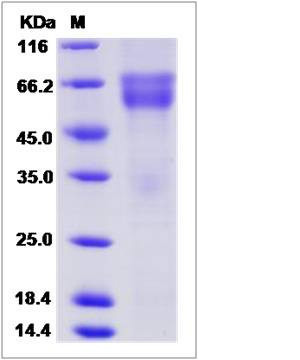Human HVEM / TNFRSF14 Protein (His & Fc Tag)
ATAR,CD270,HVEA,HVEM,LIGHTR,TR2
- 100ug (NPP3967) Please inquiry
| Catalog Number | P10334-H03H |
|---|---|
| Organism Species | Human |
| Host | Human Cells |
| Synonyms | ATAR,CD270,HVEA,HVEM,LIGHTR,TR2 |
| Molecular Weight | The recombinant human HVEM/Fc is a disulfide-linked homodimeric protein after removal of the signal peptide. The reduced monomer consists of 413 amino acids and predicts a molecular mass of 45.4 kDa. By SDS-PAGE under reducing conditions, the apparent molecular mass of rh HVEM/Fc monomer is approximately 60-65 kDa due to glycosylation. |
| predicted N | Pro 37 |
| SDS-PAGE |  |
| Purity | > 85 % as determined by SDS-PAGE |
| Protein Construction | A DNA sequence encoding the extracellular domain (Met 1-Val 202) of human HVEM (NP_003811.2) precursor was fused with the C-terminal polyhistidine-tagged Fc region of human IgG1 at the C-terminus. |
| Bio-activity | |
| Research Area | Cardiovascular |Angiogenesis |Cytokines / Chemokines in Angiogenesis |TNF Superfamily |Processes Regulated by TNF Superfamily Members |Regulation of Natural Killer Cell Co-stimulation by TNF Superfamily Members | |
| Formulation | Lyophilized from sterile 100mM Glycine, 10mM NaCl, 50mM Tris, pH 7.5 1. Normally 5 % - 8 % trehalose, mannitol and 0.01% Tween80 are added as protectants before lyophilization. Specific concentrations are included in the hardcopy of COA. |
| Background | Herpesvirus entry mediator (HVEM), also referred to as TNFRSF14, TR2 (TNF receptor-like molecule) and ATAR (another TRAF-associated receptor), is a member of type I transmembrane protein belonging to the TNF-receptor superfamily. It is expressed on many immune cells, including T and B cells, NK cells, monocytes, and neutrophils. Two TNF superfamily ligands lymphotoxin α (TNF-β) and LIGHT (TNFSF14) are identified as cellular ligands for HVEM and initiate the positive signaling. However, recent studies have revealed that HVEM is also involved in the unique inhibitory signaling pathway for T cells through activating tyrosine phosphorylation of the immunoreceptor tyrosine-based inhibitory motif (ITIM) in B and T lymphocyte attenuator (BTLA). HVEM provides a stimulatory signal following engagement with LIGHT (TNFSF14) on T cells. In contrast, it can also provide an inhibitory signal to T cells when it binds the B and T lymphocyte attenuator (BTLA), a ligand member of the Immunoglobulin (Ig) superfamily. Thus, HVEM may be viewed as a molecular switch, capable of facilitating both stimulatory and inhibitory cosignaling in T cells. Substantial evidence from both human disease and from experimental mouse models has indicated that dysregulation of the LIGHT-HVEM-BTLA cosignaling pathway can cause inflammation in the lung and in mucosal tissues. |
| Reference |
